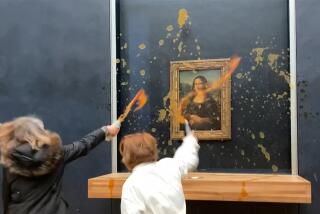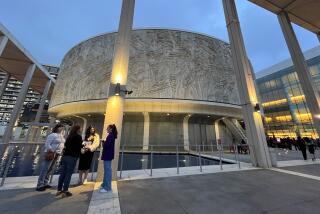The arts’ nouveau funding
- Share via
Unprecedented spending is the Bush administration’s plan to avoid the worst or something like it in the American economy. But many arts organizations can quip that they were way ahead in the rush to embrace Mother Necessity in hopes of begetting Invention.
What many of them called “the perfect storm” hit in 2001. The tech-bubble burst, the World Trade Center was attacked, and economic recession ensued, discouraging donors and ticket buyers, curtailing government grants and leading to layoffs, cancellations, deferred expansion plans and downsized theatrical seasons and productions.
Charitable gifts to the arts rebounded with the stock market, but in many cases attendance did not, as the public’s fascination with the Internet and home electronics accelerated.
The bottom line is that worries never left, experts say, so arts decision-makers didn’t need the current financial crisis to snap them to attention. There has been an ongoing urgency to face the new music and dance -- not the old-fashioned waltz but steps unimagined before Necessity called.
Dance, in fact, is the canary in the coal mine. During the 1990s, says John Munger, research director for the national service organization Dance/USA, it was typical for no more than six to 10 of the 80 or so companies with budgets over $1 million to cut spending in any given year. Since 2001, at least 20 a year and as many as 44 have been compelled to downsize.
“This is a fragile situation for professional dance,” Munger says, declining to speculate what might happen if the economy at large goes into shock. At least, he says, the performance world’s gazelles are trying not to behave like deer in the headlights.
“Dramatic and exciting changes” are afoot and showing signs of success as dance companies try to find new ways to get through to people, he says.
“You no longer market a performance that you sit and look at. What you offer is a complete experience that begins before the performance even starts and may continue afterward.”
In other words: an evening, not a show. Meals and discussions beforehand, maybe dance lessons in the lobby after. “We’re undergoing a lot of very inventive and idiosyncratic thinking, limited only by human ingenuity,” says the arts researcher, who is based in St. Paul, Minn.
Munger cites a room-by-room culinary tour of a private home in St. Paul, in which each course of the meal was accompanied by a sequence in an unfolding dance piece. On a grander scale, the Merce Cunningham Dance Company performed its “Ocean” this month in a remote granite quarry outside Minneapolis, with bus ride included.
Another tactic, he says, is creating new dances to lure those who want something fresh while retaining more conservative audiences by setting those works on the bones of familiar stories, such as “Anna Karenina,” “The Three Musketeers” and “A Streetcar Named Desire.”
Business as usual also has lost its authority in the nonprofit theater world, where surveys by Theatre Communications Group, a service organization, show a 6% drop in annual attendance from 2003 to 2007. Opera too has failed to regain its late 1990s attendance peak, according to Marc Scorca, president of the service group Opera America.
Creativity in enticing ticket buyers has become essential along with creativity onstage, says Susan Medak, managing director of Berkeley Repertory Theatre and president of the League of Resident Theaters, a consortium of about 80 large and midsize companies.
“It’s been fun, a very stimulating time for nonprofit organizations, because all bets are off,” Medak says. “You throw all sorts of preconceptions out the window and find new programs, new ways of interacting with the audience.”
It’s harder to turn a ship as big as a classical orchestra or an opera company, but Jesse Rosen, president of the League of American Orchestras, says the pace of innovation is picking up among those institutions as well. He envisions more multimedia performances a la “The Tristan Project,” the Los Angeles Philharmonic’s critically hailed 2004 translation of Wagnerian music into a video-art experience with projections from artist Bill Viola.
If orchestras are going to attract audiences, Rosen says, “there has to be a case made, really compelling reasons for why this is special.”
Maybe salvation lies in cracking codes from reality television, suggests Sandra Gibson, president of the Assn. of Performing Arts Presenters.
“What is it in the culture that makes ‘Dancing With the Stars’ and ‘So You Think You Can Dance’ so loved?” Gibson asks. After the answer is determined, she says, perhaps that wisdom can be applied to the arts.
Meanwhile, groups increasingly are hanging together for fear of hanging separately. Among them is a programming consortium of 14 major campus-based performance presenters, including UCLA Live.
“People are looking for examples, cases, demonstrations and who are the colleagues they can talk to. Nobody wants to feel they’re going it alone out there,” Gibson says.
Museums, for their part, have had an easier ride: Surveys by the American Assn. of Museums and the federal Institute of Museum and Library Services show that museums of all sorts had 550 million visits in 1999 but that last year the total was 800 million.
Museums offer visitors flex-time, a very 21st century concept, says Ben Cameron, program director for the arts at the Doris Duke Charitable Foundation in New York.
“You can go at 10 a.m., 3 in the afternoon, sometimes after 10 at night,” he says. “You can choose your own narrative: ‘I’m going to spend five seconds in front of the Chagall and five minutes in front of the Picasso.’ They are in sync with emerging customer expectations.”
Pluck, flexibility and eagerness to innovate in the arts are fine things, but the strength of such intangibles against another “perfect storm” that sucks money from each pot that nonprofit arts groups need to tap is another mat- ter.
Ticket sales and other earned income account for half the revenue of the average nonprofit arts group, according to Americans for the Arts, a service and lobbying group for local government arts agencies.
Individual donors and the arts groups’ endowments account for 35.5%; federal, state and local governments, a combined 7%; charitable foundations, 5%; and corporations, 2.5%. The National Endowment for the Arts may be the nation’s highest-profile arts funder, but its $144-million budget packs just two-thirds the inflation-adjusted buying power the agency had at its 1992 peak.
Robert Lynch, president of Americans for the Arts, hopes that while government bails out banks and investment firms, it will dig down to preserve America’s creative capital as well.
The danger in a time of crisis, he says, is that again, the arts will be seen as society’s filigree, “just another area to cut in a bad economy.”
“There’s serious stress and anxiety,” says Gibson of the performing arts presenters’ association. “The [economic] shifts and changes we’re seeing now are significant, they’re perilous.”
“Everyone is watching very carefully,” says Scorca, the Opera America president. “My sense is there is silence in the room, and people are listening very carefully to whether the storm will hit or pass over.”
--
More to Read
The biggest entertainment stories
Get our big stories about Hollywood, film, television, music, arts, culture and more right in your inbox as soon as they publish.
You may occasionally receive promotional content from the Los Angeles Times.











